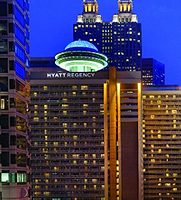Hospitality: Hyatt Regency Atlanta

The Hyatt Regency Atlanta is a 1,260-room luxury hotel near Atlanta’s city center, encompassing some 1,487,000 square feet in three towers.
Scope
The prior configuration consisted of one chiller room, one mechanical room with an additional chiller and a low-pressure steam boiler plant, and a third mechanical room containing a high-pressure steam boiler plant. The two chiller plants were consolidated into a single plant, and the two steam boiler facilities were consolidated into a single low-pressure facility. The scope of the renovation projects was based on a Central Plant Assessment completed in 2005 by Grumman/Butkus Associates. Project cost was $4.5 million.
Summary
The chilled water plant was replaced in the winter of 2011-12. Two existing chiller plants were consolidated, and a plate heat exchanger hydronic economizer was incorporated. Two new chillers (500 ton and 800 ton), plus condenser and chilled water pumps, were added to the existing 1,000-ton unit. The chillers were pre-purchased based on a life cycle cost analysis. All pumps were equipped with variable frequency drives. The hydronic economizer provides non-mechanical cooling during spring, fall and winter months when mechanical cooling was previously needed. While not a requirement of ASHRAE Standard 90.1 at the time of design, consideration was given to piping the hydronic economizer in series with the chillers. However, due to the load and operating temperatures of the existing chilled water distribution, an integrated economizer provided little or no benefit and was not included in the design.
The system was converted to a variable-primary chilled water flow. Piping was reconfigured to correct existing flow deficiencies and to allow for more efficient operation. Chilled water system control optimizes energy efficiency.
Features include:
- Condenser water reset based on ambient wet bulb
- Variable-primary chilled water distribution
- Chilled water temperature reset
- Continuous calculation of plant operating efficiency for benchmarking (kW/ton hourly, daily, weekly and monthly)
- Cooling tower de-ice mode (used with the hydronic economizer)
- Condenser water flow reset based on the number of active chillers and load
The steam boiler plant was replaced in the summer and fall of 2013. The low-pressure and high-pressure plants were consolidated into a single low-pressure boiler plant. The earlier chiller plant reconfiguration cleared space to allow new steam boilers to be installed in the low-pressure boiler plant. The high-pressure plant was kept on-line for domestic hot water production until the low-pressure plant became fully operational; it was then removed, and the space was re-purposed for a new emergency generator.
Four new 300-hp flexible-tube steam boilers were installed, along with a new boiler feed water system (including four feed pumps), a chemical treatment system, and upgraded ventilation and heating for the room. Controls include automated boiler sequencing, oxygen trim control, and boiler integration to the BAS.
Innovative features
The new variable-primary chiller configuration corrected a previous problem where the most efficient chiller could not be equally loaded in certain scenarios. Condenser water flow is controlled based on the number of chillers in operation. Tower condenser water is reset based on ambient wet bulb temperature. Two sets of ambient sensors were installed, given the importance of wet bulb readings (condenser water reset) and dry bulb (hydronic economizer operation). Any deviation between the readings of the two sets of sensors results in an alarm and calibration alert.
Boilers were shipped in knockdown form for field assembly in order to be rigged to the boiler room. Distribution piping was re-configured, and pressure-reducing stations were removed to allow for the elimination of high-pressure steam. The boiler room is two stories below grade; two variable-speed boiler flue exhaust systems were installed, permitting use of existing flue routing to the roof. New HVAC features serving the chiller and boiler rooms improved indoor air quality, comfort, and safety for facilities staff.
Results
Overall energy use for the hotel has dropped from 123,000 MMBtu/yr to 110,000 MMBtu/yr, a 10.6 percent decrease. Reductions represent an annual electrical cost savings of $103,900, plus measured gas cost savings of $52,930 for the first 10-month period following completion of the boiler plant project. The renovation conserves water and also removed equipment with CFC refrigerants that contributed to ozone depletion.




